| We left Queenstown and Arrowtown gold fields only to find ourselves in another
gold field along the Kawerau Gorge. Roaring Meg is a boisterous creek which enters the
river in the narrowest part of the gorge. Jet boats operate here also. We
spent the entire day while travelling between Queenstown and Wanaka exploring old gold
fields.
Kawerau was particularly interesting. The 25 hectare property belongs to the
Department of Conservation and is leased to the site operator/managers. The tour costs $10
NZ including 'all you can pan' for gold. You may keep any gold you find and the shop sells
little vials for $5.00 for you to put your gold into. The vials cost more than the gold! |
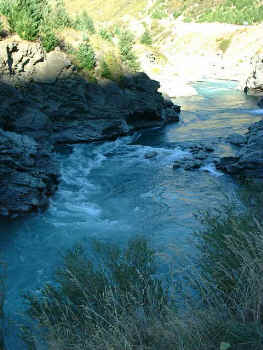 |
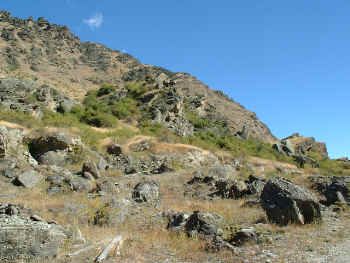 |
Anyway, we decide to take the tour to understand the gold industry as it was
from the initial find around 1860 until the last time the fields were mined during the
Great Depression of the 1930's. The surrounding hills are almost bare of
trees. There are bushes and grass. When gold was found there was only grass. All the
bushes, shrubs (including rose bushes for vitamin C) and trees were planted by the miners.
|
| There are buildings left on the hillside from the three periods the field was
active. This photo shows buildings from two periods. The stone hut is from the early 20th
century while the wooden buildings are most recent. The bridge has a
track for wheeled carts that brought ore from the mine shaft to the stamping mill called a
quartz battery. |
 |
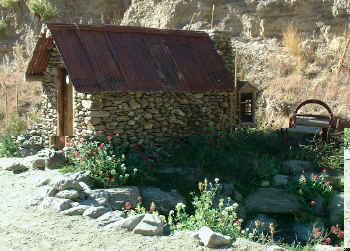 |
The stone hut may have been occupied by a Chinese miner. It is very small with
low headroom. There is only room for a short narrow cot and a fireplace. There
is a tailrace behind the hut for running water. The pink flowers are Valerian and may have
been planted by the hut resident for use as a tea. |
| The first miners panned for gold at the edges of the river and then dug pits
with pick and shovel to get at the more rich gold bearing clay ground. At
the turn of the century, during the second period of mining, the principal method of
getting at the gold bearing clay was by water sluicing. A pond at a higher elevation
provided the water to the 'monitors' that sprayed the terraces. The rocks and gold bearing
clay washed down a sluice that trapped gold in riffles or grooves.
The gold deposits at Kawerau are alluvial, washed down from the high mountains
over the centuries by glaciers and rivers and deposited under layers of gravel. The gold
is loose and can be nuggets or small dust particles. |
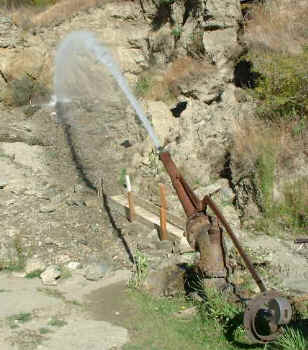 |
 |
During the depression miners dug shafts to get to the gold bearing
clay. This tunnel, seen from the outside and inside, has tracks leading to the
bridge seen in a previous photo. As the gold ore was dug out by hand using picks and
shovels by one team of men, a second crew operated the quartz battery that pounded the ore
to get at the gold. |
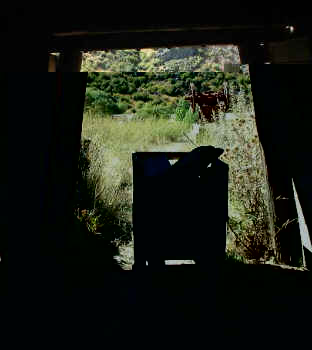 |
| We walked around the gold field and looked at several stone huts. Most had been
reconstructed for a film that was shot here. Otherwise there would be little more than
heaps of stones to mark this gold field. |
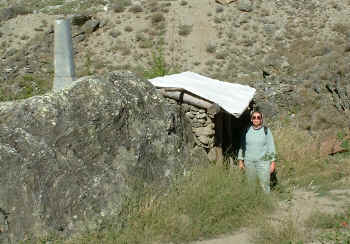 |
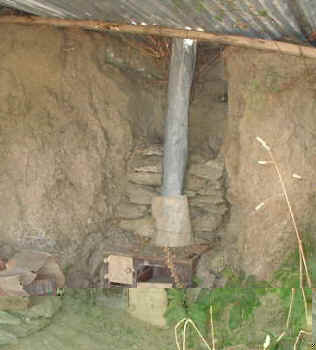 |
A pretty basic kitchen in one lean-to. This didn't appear to be more than just
a tin roof supported by a gravel bank on one end and posts on the other. |
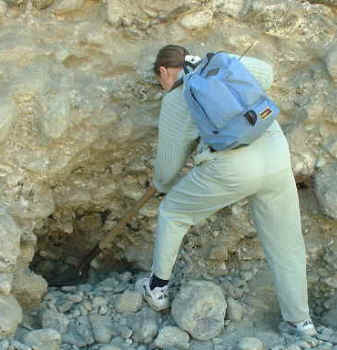 |
Here's the real reason we came here. Paula tries her luck at
panning. The first step is to place some gold bearing gravel into a pan. Then, squatting
next to a swift rushing stream, slowly wash the sand and rocks away until only gold is
left in the pan. Gold is heavier than any of the rocks and sand and is supposed to settle
to the bottom of the pan. Let's just say that our normal professions pay
better! |
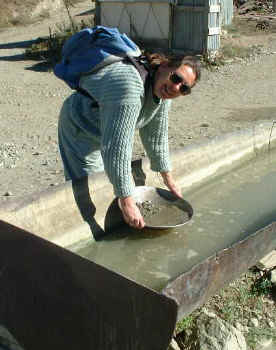 |
| This was a fun day, and we are finished (after Bendigo) with gold for a while. |
|
|
 S/V
TETHYS
S/V
TETHYS S/V
TETHYS
S/V
TETHYS